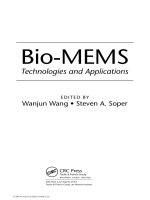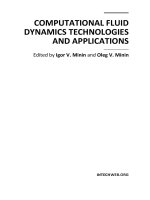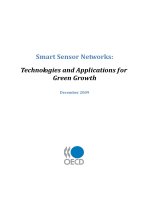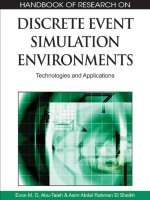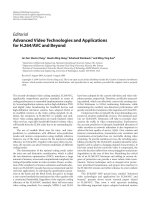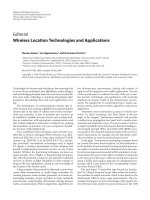Industrial iot technologies and applications international conference, industrial iot 2016
Bạn đang xem bản rút gọn của tài liệu. Xem và tải ngay bản đầy đủ của tài liệu tại đây (21.29 MB, 276 trang )
Jiafu Wan · Iztok Humar
Daqiang Zhang (Eds.)
173
Industrial IoT Technologies
and Applications
International Conference, Industrial IoT 2016
Guangzhou, China, March 25–26, 2016
Revised Selected Papers
123
Lecture Notes of the Institute
for Computer Sciences, Social Informatics
and Telecommunications Engineering
Editorial Board
Ozgur Akan
Middle East Technical University, Ankara, Turkey
Paolo Bellavista
University of Bologna, Bologna, Italy
Jiannong Cao
Hong Kong Polytechnic University, Hong Kong, Hong Kong
Falko Dressler
University of Erlangen, Erlangen, Germany
Domenico Ferrari
Università Cattolica Piacenza, Piacenza, Italy
Mario Gerla
UCLA, Los Angeles, USA
Hisashi Kobayashi
Princeton University, Princeton, USA
Sergio Palazzo
University of Catania, Catania, Italy
Sartaj Sahni
University of Florida, Florida, USA
Xuemin (Sherman) Shen
University of Waterloo, Waterloo, Canada
Mircea Stan
University of Virginia, Charlottesville, USA
Jia Xiaohua
City University of Hong Kong, Kowloon, Hong Kong
Albert Zomaya
University of Sydney, Sydney, Australia
Geoffrey Coulson
Lancaster University, Lancaster, UK
173
More information about this series at />
Jiafu Wan Iztok Humar
Daqiang Zhang (Eds.)
•
Industrial IoT Technologies
and Applications
International Conference, Industrial IoT 2016
Guangzhou, China, March 25–26, 2016
Revised Selected Papers
123
Editors
Jiafu Wan
School of Mechanical and Automotive
Engineering
South China University of Technology
Guangzhou
China
Daqiang Zhang
Software Engineering
Tongji University
Shanghai
China
Iztok Humar
Faculty of Electrical Engineering
University of Ljubljana
Ljubljana
Slovenia
ISSN 1867-8211
ISSN 1867-822X (electronic)
Lecture Notes of the Institute for Computer Sciences, Social Informatics
and Telecommunications Engineering
ISBN 978-3-319-44349-2
ISBN 978-3-319-44350-8 (eBook)
DOI 10.1007/978-3-319-44350-8
Library of Congress Control Number: 2016948761
© ICST Institute for Computer Sciences, Social Informatics and Telecommunications Engineering 2016
This work is subject to copyright. All rights are reserved by the Publisher, whether the whole or part of the
material is concerned, specifically the rights of translation, reprinting, reuse of illustrations, recitation,
broadcasting, reproduction on microfilms or in any other physical way, and transmission or information
storage and retrieval, electronic adaptation, computer software, or by similar or dissimilar methodology now
known or hereafter developed.
The use of general descriptive names, registered names, trademarks, service marks, etc. in this publication
does not imply, even in the absence of a specific statement, that such names are exempt from the relevant
protective laws and regulations and therefore free for general use.
The publisher, the authors and the editors are safe to assume that the advice and information in this book are
believed to be true and accurate at the date of publication. Neither the publisher nor the authors or the editors
give a warranty, express or implied, with respect to the material contained herein or for any errors or
omissions that may have been made.
Printed on acid-free paper
This Springer imprint is published by Springer Nature
The registered company is Springer International Publishing AG Switzerland
Preface
In recent years, the widespread deployment of wireless sensor networks, industrial
clouds, industrial robots, embedded computing, and inexpensive sensors has facilitated
industrial Internet-of-Things (IndustrialIoT) technologies and fostered some emerging
applications (e.g., product lifecycle management). IndustrialIoT constitutes the direct
motivation behind industrial upgrading (e.g., the implementation of smart factory of
Industrie 4.0).
With the support of all kinds of emerging technologies, IndustrialIoT is capable of
continuously capturing information from various sensors and intelligent units, securely
forwarding all the data to industrial cloud centers, and seamlessly adjusting some
important parameters via a closed loop system. Also, IndustrialIoT can effectively
detect failures and trigger maintenance processes, autonomously reacting to unexpected
changes in production. However, we are still facing some challenges, for example, it is
very difficult to capture, semantically analyze, and employ data in a coherent manner
from heterogeneous, sensor-enabled devices (e.g., industrial equipment, assembly lines,
and transport trucks) owing to the lack of measurement tools, collection protocols,
standardized APIs, and security guidelines.
2016 International Conference on Industrial IoT Technologies and Applications was
held on March 24–26, 2016 in Guangzhou, China. The conference is organized by the
EAI (European Alliance for Innovation). The Program Committee received over 60
submissions from 6 countries and each paper was reviewed by at least three expert
reviewers. We chose 26 papers after intensive discussions held among the Program
Committee members. We really appreciate the excellent reviews and lively discussions
of the Program Committee members and external reviewers in the review process. This
year we chose three prominent invited speakers, Prof. Min Chen; Prof. Lei Shu and
Prof. Yan Zhang.
July 2016
Jiafu Wan
Iztok Humar
Daqiang Zhang
Conference Organization
Steering Committee Chair
Imrich Chlamtac
CREATE-NET and University of Trento, Italy
Steering Committee Members
Jiafu Wan
Min Chen
Daqiang Zhang
South China University of Technology, China
Huazhong University of Science and Technology, China
Tongji University, China
General Chair
Jiafu Wan
South China University of Technology, China
General Vice Chairs
Iztok Humar
Daqiang Zhang
University of Ljubljana, Slovenia
Tongji University, China
Technical Program Committee Co-chairs
Chin-Feng Lai
Jaime Lloret
Tarik Taleb
National Chung Cheng University, Taiwan
Polytechnic University of Valencia, Spain
Aalto University, Finland
Workshops Chair
Pan Deng
Chinese Academy of Sciences (ISCAS), China
Publicity and Social Media Chair
Houbing Song
West Virginia University, USA
Sponsorship and Exhibits Chair
Shiyong Wang
South China University of Technology, China
VIII
Conference Organization
Publications Co-chairs
Hu Cai
Zhaogang Shu
Jing Su
Jiangxi University of Science and Technology, China
Fujian Agriculture and Forestry University, China
Guangdong Ocean University, China
Local Chair
Xiaomin Li
Hu Cai
South China University of Technology, China
JJiangxi University of Science and Technology, China
Web Chair
Hu Cai
Jiangxi University of Science and Technology, China
Technical Program Committee
Houbing Song
Li Qiu
Lei Shu
Yan Zhang
Yunsheng Wang
Dewen Tang
Yupeng Qiao
Leyi Shi
Qi Jing
Caifeng Zou
Seungmin Rho
Pan Deng
Kai Lin
Meikang Qiu
Feng Xia
Chi Harold Liu
Jianqi Liu
Heng Zhang
Chao Yang
Tie Qiu
Guangjie Han
Feng Chen
Dongyao Jia
Yin Zhang
Qiang Liu
Fangfang Liu
West Virginia University, USA
Shenzhen University, China
Guangdong University of Petrochemical Technology,
China
Simula Research Laboratory, Norway
Kettering University, USA
University of South China, China
South China University of Technology, China
China University of Petroleum, China
Peking University, China
South China University of Technology, China
Sungkyul University, South Korea
Chinese Academy of Sciences (ISCAS), China
Dalian University of Technology, China
Pace University, USA
Dalian University of Technology, China
Beijing Institute of Technology, China
Guangdong University of Technology, China
Southwest University, China
Institute of Software, Chinese Academy of Sciences, China
Dalian University of Technology, China
Hohai University, China
Chinese Academy of Sciences, China
University of Leeds, UK
Zhongnan University of Economics and Law, China
Guangdong University of Technology, China
Chinese Academy of Sciences, China
Contents
Big Data
The Design and Implementation of Big Data Platform
for Telecom Operators . . . . . . . . . . . . . . . . . . . . . . . . . . . . . . . . . . . . . . .
Jing Tan
3
A Big Data Centric Integrated Framework and Typical System
Configurations for Smart Factory . . . . . . . . . . . . . . . . . . . . . . . . . . . . . . .
Shiyong Wang, Chunhua Zhang, and Di Li
12
Data Acquisition and Analysis from Equipment to Mobile Terminal
in Industrial Internet of Things . . . . . . . . . . . . . . . . . . . . . . . . . . . . . . . . .
Minglun Yi, Yingying Wang, Hehua Yan, and Jiafu Wan
24
Research About Big Data Platform of Electrical Power System. . . . . . . . . . .
Dongmei Liu, Guomin Li, Ruixiang Fan, and Guang Guo
Research About Solutions to the Bottleneck of Big Data Processing
in Power System . . . . . . . . . . . . . . . . . . . . . . . . . . . . . . . . . . . . . . . . . . .
Ning Chen, Chuanyong Wang, Peng Han, Jian Zhang, Kun Wang,
Ergang Dai, Wenwen Kang, Fengwen Yang, Baofeng Sun,
and Guang Guo
Research of Mobile Inspection Substation Platform Data Analysis Method
and System . . . . . . . . . . . . . . . . . . . . . . . . . . . . . . . . . . . . . . . . . . . . . .
Peng Li, Ruibin Gao, Lu Qu, Wenjing Wu, Zhiqiang Hu, and Guang Guo
Data Recovery and Alerting Schemes for Faulty Sensors in IWSNs. . . . . . . .
Huiru Cao, Junying Yuan, Yeqian Li, and Wei Yuan
Incremental Configuration Update Model and Application in Sponsored
Search Advertising . . . . . . . . . . . . . . . . . . . . . . . . . . . . . . . . . . . . . . . . .
Wei Yuan, Pan Deng, Biying Yan, Jian Wei Zhang, Qingsong Hua,
and Jing Tan
36
44
52
59
70
Cloud Computing
CP-Robot: Cloud-Assisted Pillow Robot for Emotion Sensing
and Interaction . . . . . . . . . . . . . . . . . . . . . . . . . . . . . . . . . . . . . . . . . . . .
Min Chen, Yujun Ma, Yixue Hao, Yong Li, Di Wu, Yin Zhang,
and Enmin Song
81
X
Contents
Cloud Robotics: Insight and Outlook . . . . . . . . . . . . . . . . . . . . . . . . . . . . .
Shenglong Tang, Jiafu Wan, Hu Cai, and Fulong Chen
Research of Construction and Application of Cloud Storage
in the Environment of Industry 4.0 . . . . . . . . . . . . . . . . . . . . . . . . . . . . . .
Kaifeng Geng and Li Liu
94
104
IoT
A Novel Integrated GSM Balun Design and Simulation . . . . . . . . . . . . . . . .
Bing Luo, Jianqi Liu, Yongliang Zhang, Yanlin Zhang, and Bi Zeng
117
A Novel Vehicular Integrated Positioning Algorithm . . . . . . . . . . . . . . . . . .
Jianqi Liu, Yanlin Zhang, and Bi Zeng
125
Electronic Commerce Platform of Manufacturing Industry Under Industrial
Internet of Things . . . . . . . . . . . . . . . . . . . . . . . . . . . . . . . . . . . . . . . . . .
Yingying Wang, Hehua Yan, and Jiafu Wan
A Secure Privacy Data Transmission Method for Medical Internet of Things. . . .
Heping Ye, Jie Yang, Junru Zhu, Ziyang Zhang, Yakun Huang,
and Fulong Chen
137
144
Robust Topology and Chaos Characteristic of Complex Wireless
Sensor Network . . . . . . . . . . . . . . . . . . . . . . . . . . . . . . . . . . . . . . . . . . .
Changjian Deng and Heng Zhang
155
A Novel Algorithm for Detecting Social Clusters and Hierarchical Structure
in Industrial IoT . . . . . . . . . . . . . . . . . . . . . . . . . . . . . . . . . . . . . . . . . . .
Jiming Luo, Kai Lin, and Wenjian Wang
166
Junction Based Table Detection in Mobile Captured Golf Scorecard Images . . .
Junying Yuan, Haishan Chen, Huiru Cao, and Zhonghua Guo
179
Developing Visual Cryptography for Authentication on Smartphones. . . . . . .
Ching-Nung Yang, Jung-Kuo Liao, Fu-Heng Wu,
and Yasushi Yamaguchi
189
A Scale-Free Network Model for Wireless Sensor Networks in 3D Terrain . . . .
Aoyang Zhao, Tie Qiu, Feng Xia, Chi Lin, and Diansong Luo
201
Service Model and Service Selection Strategies for Cross-regional
Intelligent Manufacturing . . . . . . . . . . . . . . . . . . . . . . . . . . . . . . . . . . . . .
Xinye Chen, Ping Zhang, Weile Liang, and Fang Li
A Model-Based Service-Oriented Integration Strategy for Industrial CPS . . . .
Fang Li, Ping Zhang, Hao Huang, and Guohao Chen
211
222
Contents
Research on the Link Quality Prediction Mechanism Based on ARIMA
Model for Multi Person Cooperative Interaction . . . . . . . . . . . . . . . . . . . . .
Shu Yao, Chong Chen, and Heng Zhang
Design of Multi-mode GNSS Vehicle Navigation System. . . . . . . . . . . . . . .
Zhijie Li, Jianqi Liu, Yanlin Zhang, and Bi Zeng
Intelligent Storage System Architecture Research Based on the Internet
of Things . . . . . . . . . . . . . . . . . . . . . . . . . . . . . . . . . . . . . . . . . . . . . . . .
Li Liu and Kaifeng Geng
XI
231
240
247
Design of Remote Industrial Control System Based on STM32. . . . . . . . . . .
Rongfu Chen, Yanlin Zhang, and Jianqi Liu
257
Author Index . . . . . . . . . . . . . . . . . . . . . . . . . . . . . . . . . . . . . . . . . . . .
269
Big Data
The Design and Implementation of Big Data Platform
for Telecom Operators
Jing Tan ✉
(
)
Shenyang Artillery Academy, Shenyang, China
Abstract. This paper introduces the background of developing big data platform
for telecom operators, and the benefits for telecom operators to using big data
platform in some aspects that may improve forward and back changings. This
document also presents a method of build big data platform using Hadoop
according to the particularities of the data and systems in the telecom operators,
and the implementation of this method in the internet department of a provincelevel telecom operator company.
Keywords: Big data · Telecom operators · Hadoop
1
Introduction
1.1 Background
Big data technology is broadly used in variety industries and companies providing tech‐
nical support for marketing strategy. For instance, T-Mobile a Germany telecom oper‐
ator use big data to integrate social media data, CRM and billing data that reduced
customer churn rate into half in one season [1], and Walmart discern meaningful big
data insights for the millions of customers to enjoy a personalized shopping experience
with customers’ shopping behavior data from on-and-off line [2].
Big data can be described by four characteristics [3] as follows:
(1) Volume: The size of data increases from TB to ZB with the growth of internet,
mobile phone and sensors [4].
(2) Variety: Different with the structure data, types of unstructured data increases
rapidly, like audio streams, video streams, images and geographic data.
(3) Velocity: The data is generated and processed fast to meet the demands and chal‐
lenges of the companies’ development and growth.
(4) Veracity: The quality of captured data can vary greatly. Accurate analysis depends
on the veracity of source data.
Data generated from telecom operators also has these characteristics, take a middle
class province of China Unicom as example, in 2012, internet access records reached
1 billion per day, and the quantity of these data is 9T per month [5]. Now, telecom
operators start establishing big data platform and mining user profile to support business
sales.
© ICST Institute for Computer Sciences, Social Informatics and Telecommunications Engineering 2016
J. Wan et al. (Eds.): Industrial IoT 2016, LNICST 173, pp. 3–11, 2016.
DOI: 10.1007/978-3-319-44350-8_1
4
J. Tan
1.2 Hadoop Introduction
Hadoop is a framework for distributed processing and Analysis of large data sets across
clusters of computers using simple programing models [6]. Hadoop is originally present
from Apache Nutch a sub-projects of Apache Lucene which is start from 2002 [7]. In
2004, Google published a paper entitled “MapReduce: Simplified Data Processing on
Large Clusters” in OSDI (Operating System Design and Implementation) [8] which
purpose MapReduce the most important modules in Hadoop for the first time. In the
early 2008, Hadoop became Apache top-level project which including many subprojects, such as Hive, HBase, Pig which are already graduated to be top-level projects
in 2010. The core components of Hadoop framework consist of HDFS and MapReduce.
HDFS (Hadoop Distributed File System) [9] is a distributed file system that provides
high-throughput access to application data, in the meantime, MapReduce is a framework
for job scheduling and cluster resource management system for parallel processing of
large data sets.
Hadoop has five benefits [10] as follows:
(1) High reliability: Single-Point or Multi-Point failure cannot interrupt Hadoop’s
service.
(2) High scalability: Hadoop allocated and computed in the Hadoop cluster that could
be easily scale to thousand node.
(3) High performance: Hadoop can move the data among the datanodes dramatically
to guarantee the equilibrium of each nodes that would be fast in processing speed.
(4) High fault tolerance: Hadoop can automatically save the data in several copies, and
can voluntarily relocate the jobs that are failure.
(5) Low-cost: Compare with database machine, business data warehouse and other data
mart, Hadoop is an open source software that would substantially reduce the soft‐
ware cost in projects.
With the advantages of Hadoop, many companies chose Hadoop as framework to
build up big data platform, including IBM, Adobe, LinkedIn, Facebook [11, 12], so
Hadoop could be the choice for telecom operators.
2
The Importance of Developing Big Data Platform for Telecom
Operators
Along with mobile network’s development, the amount of mobile data increased a lot.
However, the revenue of telecom operators does not increase as well. Moreover, the
traditional income keep going down as it occupied by mobile data’s generator (the third
party business in substitution type). Even worse, Telecom operators is going to play as a
channel. Therefore, how to take advantage of “channel” role, getting data resource from
“channel”, controlling another core-competitiveness outside of networking resource is the
top question for Telecom operators, in developing mobile network business.
The Design and Implementation of Big Data Platform
5
2.1 Improving Business Innovation Ability
Base on analysis of large amount of data, understanding customer’s requirement, and
then lead to business improvement. After business online, keep tracking and analyzing
customer’s behavior, such as how to find it, and ordering and usage, as well as any
existing problems. These data is the foundation of making strategy for business improve‐
ment, enhance business’s practicability and convenience, improving business quality
and customer experience. Take network optimization as an example, we can use big data
technique to analyze network traffic, and trend. Then modify resource configuration in
short time, meanwhile, analyzing network log, improve the whole of network, and keep
improve network quality and capacity, as well as customer’s networking experience.
2.2 Improving the Efficiency of Marketing Promotion
Nowadays, Telecom operators still focus on fixed package in the aspect of traffic oper‐
ation business, still using fixed pattern for setting package, instead of on user’s demand.
Base on analysis of user’s requirement and characteristic of behavior, we can filter out
the target user, matching right product, determining the good time for showing and
selling for customer. Moreover, we can combine channel characters and channel execu‐
tion, developing precision marketing that is based on requirement subdivision and users’
precise positioning. Then enhance the standardization of customer’s resource manage‐
ment, matching customer’s requirement and product features, and finally raising custom‐
er’s satisfaction and marketing efficiency.
2.3 Exploring New Business Mode
Exploring new business mode includes enhancement of traditional forward charging, as
well as developing new mode of back charging.
(1) Enhancement of Forward Charging: By improving the ability of business inno‐
vation and smart marketing, Telecom operators’ ability in forward charging will be
improve. Base on that, Telecom operators is able to provide personalized service,
and targeted products and services for different level users. Then raising product’s
value and enhance the ability of forward charging.
(2) Exploring New Mode of Back Charging: Refer to internet business mode;
telecom operators could have variety of Back-charging business mode.
(a) Smart Marketing: The profit model for Telecom operators is using big data
technique to provide smart marketing and precise matching product require‐
ment, combine with easy channel system. All of these can help business partner
achieve sales targets rapidly, and then business partner will pay corresponding
commission for Telecom operators.
(b) Consultant Services: In the process of developing product, marketing plan‐
ning and product optimization, Telecom operators provides comprehensive
consultant service, which is based on data analysis for business partners, to
improve the product’s competitive and operating efficiency. Related consultant
service is one of profit points for Telecom operators.
6
J. Tan
(c) Precision Advertising: Precision advertising is most valuable mode in backcharging model. Telecom operators has huge number of user groups that are
all potential advertising audience. In the meanwhile, diversified media which
telecom operators occupied covers multi-aspect of advertising audience
become valid carrier of advertisement. More important is by controlling all
aspect information of advertising audience; it is easy to achieve targeted
advertising and effectiveness, and will be more attractive for advertisers.
2.4 Improving Influence of Industry Chain
Deep processing data, providing information service, and create more opportunity that
is new for companies without violate user’s privacy. Therefore, big data technology will
help telecom operators transform from web service provider to information provider.
The competition of mobile network is the competition of data scale and quality, instead
of number of users, or product itself. The key action of improving influence of industry
chain is trying to get more high quality data and controlling more key nodes of getting
data.
3
The Big Data Platform Architecture for Telecom Operators
Big Data Platform Architecture: big data platform includes three main parts: Data
Collection layer, Big Data layer and Data Sharing layer which is shown in Fig. 1. Data
Sources provide the data that used for store and analysis.
3.1 Data Sources
Main data comes from three channels: user network accessing interface signaling data,
internal system data, and internet spider data.
(1) User network accessing interface signaling data come from GB port, IUPS port,
GN port, LTE port and WLAN port. All of these data is web pages’ session via
different network, including user-browsing website’s IP address, time etc.
(2) Internal system data comes from internal operation system, such as BOSS (Busi‐
ness & Operation Support System), CRM (Customer Relationship Management),
TAMS (Telecom Marketing & Analysis System). BOSS system consists of network
management, system management, billing system, business, and finance, and
customer service. BOSS system provides networking data, billing data, and
customer data etc. CRM system is able to provide marketing data and user data.
TMAS provides business data and customer consumption data etc.
(3) Network spider data mainly use spider to extract network information, and then
provide data foundation that used to analysis customer’s behavior of surfing on
internet.
The Design and Implementation of Big Data Platform
7
Fig. 1. The Architecture of Big data platform for telecom operators.
3.2 Data Collection Layer
Against three different data sources from Data Sources, use different way to collect data,
include DPI/DFI data collection interface, internal data collection interface and external
data collection interface.
(1) DPI/DFI Data Collection Interface: Collect user network interface signaling data,
this system get the IP datagram from OBD (Optical Branching Device) which is
connected in backbone network and analysis to the web session, so DPI data collec‐
tion interface is handling user’s web session records.
(2) Internal Data Collection Interface: Collect telecom operators’ internal system
data. This part already builds up relational database system, such as Oracle. Thus
internal data collection interface is using JDBC or ODBC to get data from relational
database system.
(3) External Data Collection Interface: Collect spider data. Network spider has
sorted out the data that extract from internet, and store it in file system or database.
Thus, external data collection interface is accessing file system or database system.
8
J. Tan
3.3 Big Data Layer
Big data layer provide big data infrastructure, big data storage and big data analysis,
store the data from data collection layer into big data layer.
(1) Big Data Infrastructure: Big data distributed cluster base on Hadoop, providing
foundation for big data storage and analysis, supporting high speed and high avail‐
ability data storage and processing.
(2) Big Data Storage: Choose proper way to store the data based on data’s features
and application. Mainly use HDFS and HBASE. For DPI/DFI collected signaling
data, original signaling data stores in file system. For the purpose of detail query,
use external file connected to Hive. Processed daily data or monthly data stores in
HBASE, IMEI are the key. Stored data includes Mobile Information, User Infor‐
mation, User Behavior, Billing Information, APP category, Website Category.
(3) Big Data Analysis: Analyzing and digging the data from Big Data Storage, getting
new data that is supporting business extension. Data analysis includes:
(a) User Profile: Labeling user’s personality, according to gender, age, address,
and consumer power, hobby etc., which is supporting smart marketing and
precision advertising.
(b) Information Completion: When user registering personal information, many
data is incomplete or wrong, so we can use Data mining technique to complete
or correct the personal data.
(c) User Credit: Analyzing user’s consumption and other basic data, getting
user’s credit evaluation, provides to Bank or Credit Information Company.
(d) Product Popularity: Analyzing Telecoms’ product popularity, supporting
marketing.
(e) Product Life Circle: Analyzing Telecoms’ product life circle, understanding
this product’s operating.
(f) Social Circle: Analyzing user’s social circle, supporting smart marketing.
3.4 Data Sharing Layer
Data sharing layer adopt unified data accessing interface, open it to telecoms internal
use, or open secure interface for external company to personal to use.
4
The Implementation of Big Data Platform
This architecture of big data platform for telecom operators is implemented in the
internet department of a middle-class province for collecting and storing user internet
accessing data, acquiring users’ internet accessing behaviors. Combining with the users’
demographic data, we use this platform to analysis the popularity and characteristic of
the music, reading and game products of this department, and present marketing strat‐
egies for these products.
The Design and Implementation of Big Data Platform
9
Fig. 2. The implementation of big data platform architecture in a province telecom operator.
Figure 2 shows the implementation of big data platform architecture in a province
telecom operator. It includes two main parts, data collection servers and Big Data Infra‐
structure. In addition, DPI servers are very significant in telecom operators’ network for
gathering user internet accessing data but not a component in big data platform.
(1) DPI Server: DPI server is the data source of user internet data. DPI servers gather
user signaling data from backbone network via OBD, and convert the user signaling
data to user session data.
(2) Data Collection Server: It gets user session data from DPI server, and then sends
to Big Data Infrastructure. Since the amount of session data is huge, it almost 300
thousand records per second, so this part consists of 6 servers, and each server need
to process 50 thousand records per second on average.
(3) Big Data Infrastructure: This is a Hadoop cluster, which consists of servers
including NN (NameNode) and DN (DataNode). NameNode is file system naming
space in Hadoop that maintain the whole file system tree and all the related files
and directories. DataNode is the file system’s working node, it store and indexing
10
J. Tan
data base on dispatching with client or NameNode, also sending block list for
NameNode periodically. Big Data Infrastructure is responsible for store the user
Internet accessing session data and is summed up in minute, hour and day. Big Data
Infrastructure is consist of three components:
(a) NN and NN+SNN (Secondary NameNode): NN is NameNode in Hadoop
ecosystem. NN+SNN is backup of NN that is using HA, and used as SNN.
(b) DN+Hive: It is DataNode in Hadoop, and deploy Hive on it; it stores users’ session
data, and support session query, and multi-division’s query and integration. This
part deployed nine servers and each server supports four network interfaces.
(c) DN+HBase: Deploy both DataNode and HBase. It stores users’ session details
records, as well as integrated data in minute, hour and day. Therefore, it able to do
detail query and analysis for integrated data. This part deploys nine servers and
each server supports four network interfaces.
According to above description, Data Collection Servers can upload data into DN
+Hive and DN+HBase concurrently. Each DN+Hive and DN+HBase server is setting
two internet domains. One is for NN or NN+SNN servers to access and dispatch the
data, the other is used for data collection servers to upload data to DN, so for avoiding
confusion in the physic network and guaranteeing the upload speed, DN+Hive and DN
+HBase is divided into two separate network segments which is connected by one switch
separately. The fact is this kind of architecture is able to fulfill the requirement of
concurrency that is about 300 thousand internet accessing session records per second.
5
Conclusion
This article introduced the design and implementation of big data platform for telecom
operators. The Framework of this platform is based on Hadoop. We construct the big
data platform that is special for Telecom operators. It is collecting users’ internet
accessing signaling data, internal system data and web spider data, improving the
speeding of query data and data mining for users who are interested in music, reading
and games, and providing guidelines for marketing strategy. As a result, this platform
gain very good achievement.
Nowadays, telecom operator’s traditional business, such as voice and SMS, this
part’s income is keep going down. Thus, Telecom operators is seeking new opportuni‐
ties, many Telecom operators realized the value of big data, and already constructing
big data platform. However, as the data is distributed in different BUs, it is very difficult
to integrity data. In addition, different BU’s business need is different, so it caused
repeating construction of big data platform, and skill level also not the same. However,
big data still quite important, it will bring more opportunities for Telecom Operators.
The Design and Implementation of Big Data Platform
11
References
1. How to Use Big Data to Stop Customer. />2. How Big Data Analysis helped increase Walmart’s Sales turnover? />article/how-big-data-analysis-helped-increase-walmart-s-sales-turnover/109
3. Big data. />4. Segaran, T., Hammerbacher, J.: Beautiful Data: The Stories Behind Elegant Data Solutions.
O’Reilly Media, Sebastopol (2009)
5. Wang, Z.J.: The application of hadoop in the telecom industry. Technical report, One China
One World (2012)
6. Apache Hadoop. />7. Dean, J., Ghemawat S.: MapReduce: simplified data processing on large clusters. In: OSDI,
vol. 51, no. 1, pp. 147–152 (2004)
8. Nagel, S.: Web crawling with Apache Nutch. In: ApacheCon EU 2014, Budapest (2014)
9. Shvachko, K., Kuang, H., Radia, S., Chansler, R.: The hadoop distributed file system. In:
2010 IEEE 26th Symposium Mass Storage Systems and Technologies, pp. 1–10. IEEE (2010)
10. Olson, M.: Hadoop: scalable, flexible data storage and analysis. IQT Q. 1, 14–18 (2010)
11. Borthakur, D., Gray, J., Sarma, J.S., Muthukkaruppan, K., Spiegelberg, N., Kuang, H., et al.:
Apache hadoop goes realtime at Facebook. In: Proceedings of the 2011 ACM SIGMOD
International Conference on Management of data. ACM (2010)
12. Sumbaly, R., Kreps, J., Shah, S.: The big data ecosystem at linkedIn. In: Ross, K.A.,
Srivastava, D., Papadias, D., (eds.) SIGMOD Conference, pp. 1125–1134. ACM (2013)
A Big Data Centric Integrated Framework and Typical
System Configurations for Smart Factory
Shiyong Wang, Chunhua Zhang ✉ , and Di Li
(
)
School of Mechanical and Automotive Engineering, South China University of Technology,
Guangzhou 510640, China
{mesywang,chhzhang,itdili}@scut.edu.cn
Abstract. Personalized consumption demand and global challenges such as
energy shortage and population aging require flexible, efficient, and green produc‐
tion paradigm. Smart factory aims to address these issues by coupling emerging
information technologies and artificial intelligence with shop-floor resources to
implement cyber-physical production system. In this paper, we propose a cloud
based and big data centric framework for smart factory. The big data on cloud
not only enables transparency to supervisory control but also coordinates selforganization process of manufacturing resources to achieve both high flexibility
and efficiency. Moreover, we summarize eight typical system configurations
according to three key parameters. These configurations can serve different
purposes, facilitating system analysis and design.
Keywords: Smart factory · Smart production · Smart product · Industry 4.0 ·
Industrial internet
1
Introduction
For a long time, shop-floor manufacturing resources in terms of machines and conveyers
have been carefully organized to build production lines which are efficient and low-cost
for mass production. However, the traditional production line is rather rigid so that it
will lead to a long system down time and an expensive cost to change for another product
type. To cope with ever increasing personalized consumption demands on multi-type
and small- or medium-lot customized products, many advanced manufacturing schemes
such as flexible manufacturing system (FMS) or intelligent manufacturing system (IMS)
have been proposed. The researches on FMS expect to allocate manufacturing resources
to a family of product types with a kind of central computerized controller [1, 2]. By
contrast, the multi-agent system (MAS) method, a representative IMS scheme, models
resources as autonomous agents that rely on peer to peer negotiation to dynamically
reconfigure for different product types [3, 4].
Today, emerging information technologies raise credible opportunities to implement
smart production. With cloud computing [5], big data [6–8], wireless sensor network
(WSN) [9], Internet of Things (IoT) [10], and mobile Internet [11] et al. applied in manu‐
facturing environment, machines, tools, materials, products, employees, and information
systems (e.g., ERP and MES) can be interconnected and communicate with each other.
© ICST Institute for Computer Sciences, Social Informatics and Telecommunications Engineering 2016
J. Wan et al. (Eds.): Industrial IoT 2016, LNICST 173, pp. 12–23, 2016.
DOI: 10.1007/978-3-319-44350-8_2
A Big Data Centric Integrated Framework
13
This actually forms a manufacturing oriented cyber-physical system (CPS) [12, 13] or
called cyber-physical production system (CPPS), which is the basis for smart factory
termed by industry 4.0 initiative [14]. Compared with FMS and IMS, the smart produc‐
tion enabled by smart factory features high interconnection, mass data, and deep integra‐
tion. Moreover, the product acts as a smart entity participating in the production process
actively. Therefore, based on high bandwidth network and powerful cloud, smart produc‐
tion can implement high flexibility, high efficiency, and high transparency [15, 16].
In this paper, we propose a layered framework for smart factory to integrate shopfloor entities, cloud, client terminals, and people with industrial network and Internet.
Big data and self-organization of smart shop-floor entities are two essential mechanisms
to implement smart production. Big data enables transparency and coordinates selforigination process to achieve high efficiency. Self-organization makes reconfiguration
process for multi-type products very flexible. To account for the diversity of shop-floor
manufacturing resources, e.g., digital product memories (DPM) can be classified into
storage, reference, autonomous or smart [17], and production execution can be alterna‐
tive or hybrid, we propose an analysis model and identify three key parameters,
according to which eight typical system configurations are recognized.
The article is organized as follows. In Sect. 2, we discuss the roles of cloud, big data,
and self-organization in the smart production environment. In Sect. 3, the key parameters
that affect reconfiguration ability, negotiation mechanism, and deadlock prevention are
identified based on system analysis. In Sect. 4, eight typical configurations are
constructed based on three key parameters, characteristics and application scenarios of
which are further discussed. Finally, conclusions and future work are given in Sect. 5.
2
Integrated System Framework
Smart factory focuses on vertical integration of various components inside a factory
boundary. It is a kind of manufacturing oriented cyber-physical system, i.e., cyberphysical production system that features high flexibility, high efficiency and high trans‐
parency. In this section, we present an integrated system framework and discuss related
issues.
2.1 Cloud Based Integration
Figure 1 depicts a framework to integrate shop-floor entities, servers, client terminals,
and people with industrial network and Internet. Shop-floor entities mainly include
machines (for processing, assembling, testing, and storing et al.), conveyers (such as
conveyor belts, AGVs, and loading/unloading robotic arms), and intelligent products
(being processed by the system). Servers are specific computers for hosting various
information systems such as ERP, MES, and CAX (CAD/CAE/CAM) systems. Client
terminals in the form of computers and smart mobile phones et al. are for human-system
interaction. People mainly refer to employees that distribute among various sectors, e.g.,
production, operation and maintenance, design, purchasing, sale, finance, and planning.
14
S. Wang et al.
However, non-employees such as suppliers, customers, and supervisors can also link to
this network.
Traditionally, separate servers are used for different information systems. However,
with cloud computing technology, a network of servers can be virtualized as a huge
resource pool to support elastic computing and storage demand. Therefore, different
information systems can be deployed onto the single cloud platform, and distributed
shop-floor entities and client terminals can be connected to the same cloud as well. As
a result, all the enterprise activities ranging from design and production to management
and planning are integrated based on cloud.
Fig. 1. Cloud based integrated framework of smart factory.
2.2 Big Data Based Fusion
Both shop-floor entities and client terminals can act as data terminals to gather various
kinds of data to cloud (outer race of Fig. 2). However, the simple migration of infor‐
mation systems from separate servers to the single cloud is not enough to create mean‐
ingful big data. Today’s information systems are designed to cope with different require‐
ments, e.g., CAD for product definition, MES for production process management, and
ERP for resource management. As a result, they will probably use different formats to
describe the same data object causing inconsistency to block information flow among
different systems.
For big data to come true, smart factory should be constructed in a data centric way
(inner race of Fig. 2). A unified data model including vocabulary, syntax, and semantics
should be defined to maintain consistency, continuity, and integrity of mass data. There‐
fore, different information systems can operate on the same data object set. As software
modules interact with each other through data objects, tight logic coupling can be
released so that information processing software can be further modularized and mini‐
aturized (middle race of Fig. 2). This facilitates software deployment and lower cost,
e.g., software modules can be selected on demand. Recall that both big data and infor‐
mation processing software run on cloud, whereas shop-floor entities and client termi‐
nals are connected with cloud through industry network or Internet.
A Big Data Centric Integrated Framework
Setup
client
OA
client
15
Financ
e client
Quality
Mainten
Simula
mgmt
ance
Device
tion
client
mgmt
Design
Big data
Design Planni
...
client
ng
warehouse Analys
is
Financ
Conve
Turnin
e
Material
yer
g-lathe
mgmt
…
Monitor
ing
client
Milling
mac hine
Drilling
mac hine
AGV
Fig. 2. Big data based fusion of smart factory.
2.3 Self-organization Based Resource Reconfiguration
The smart production system is designed for processing multiple types of products. The
machines are redundant and the conveying system has multiple branches. Therefore,
both machines and conveyers should be reconfigured dynamically. For example, one
product may need machines 1, 3, and 5, whereas another product may need machines
2, 4, 6, as shown in Fig. 3. Obviously, products have to go through different branches
to traverse the two different sets of machines. For distributed and autonomous machines
and conveyers, negotiation based mechanisms are suitable for reconfiguration in a selforganized way.
Machine 2
Machine 3
Machine 4
Machine 1
Machine 6
Machine 7
Machine 5
Fig. 3. Resource reconfiguration for different products.
In smart factory, the shop-floor entities are beyond the kind of numerical control
systems that have abilities of computing, communication, control, sensing, and
actuating. Smart entities can also make decisions by themselves and negotiate with
